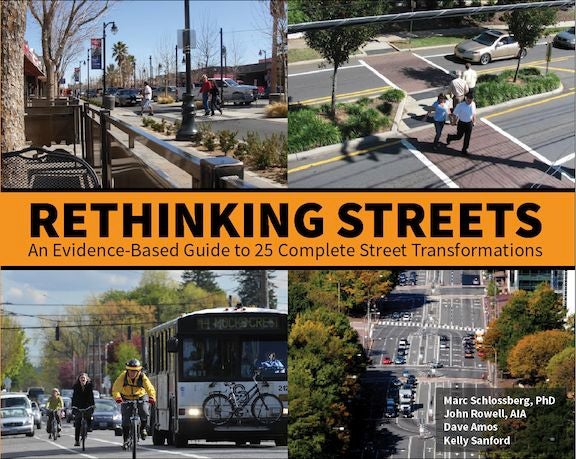Four faculty members and students from A&AA have collaborated on a book about transforming streets that were originally designed more to accommodate motor vehicles rather than pedestrians and bicyclists.
Rethinking Streets: An Evidence-Based Guide to 25 Complete Street Transformations, documents twenty-five case studies from around the country that helped facilitate more walking, biking, and transit use while enhancing commercial activity, with minimal to no negative impact on automobile access. The book was released December 2013.
 The coauthors compiled the stories into a highly visual and accessible guide that aims to help engineers, planners, policy makers, and community members approach similar endeavors. The publication is a federally funded effort through the National Institute for Transportation and Communities (NITC). Rethinking Streets will be distributed to every state department of transportation across the country and through several national professional networks.
The coauthors compiled the stories into a highly visual and accessible guide that aims to help engineers, planners, policy makers, and community members approach similar endeavors. The publication is a federally funded effort through the National Institute for Transportation and Communities (NITC). Rethinking Streets will be distributed to every state department of transportation across the country and through several national professional networks.
“The idea was inspired by Willamette Street in Eugene, which has been tried to be redone but it’s just taken up too much time and controversy and effort,” said Marc Schlossberg, associate professor in the Department of Planning, Public Policy, and Management and codirector of the Sustainable Cities Initiative. Schlossberg was one of four authors who wrote and researched the book.
UO architecture Associate Professor John Rowell, former graduate student Dave Amos, and graduate architecture student Kelly Sanford were also on the team.
The authors intended the book for a variety of audience needs. As the book’s foreword states, “In some cases, a specific street featured in this book may be directly relevant to a proposed project in your community. In other cases the collection of examples in this book may provide the foundation for creative street re-purposing.”
Types of streets vary from “arterial rehab,” urban mixed-use, bike street, transit street, and main street, in both rural and metropolitan areas. The redesigns aim to improve conditions for bicyclists, transit, and pedestrians.
Case studies range from a street in New Orleans, Louisiana, to a corridor in Philadelphia, to examples from Oregon. In New Orleans, South Carrollton Avenue was rebuilt after flooding from Hurricane Katrina. After engineers added bike lanes, cycling on the street increased 325 percent. In Philadelphia, Pine and Spruce streets previously had one travel lane, which was redesigned as a buffered bicycle lane. Car crashes declined by 30 percent in the three years since the streets were reconfigured, while traffic volumes remained constant despite the loss of one car lane.
In Charlotte, North Carolina, a commuter corridor had four vehicle lanes converted to two auto lanes, two bicycle lanes, and a center turn lane. Minimal impact was made to car traffic, and outdoor dining businesses in the district became more popular.
A sample transit street in Oregon is Southwest 5th and 6th Avenues in Portland. After a six-year construction effort, a light rail system was incorporated into a transit mall, new transit shelters were installed, and a bike lane was added. After the overhaul, observers noticed a significant decline in bus-related collisions as well as easier access for cars.
Each street in the book is provided with a four-page profile including street type classification, average daily traffic, length, speed limit, and process of construction for the redesign. Key outcomes from each restoration are listed, and range from observations on bicyclist safety to the relationship between bicyclists and vehicles.
Graduate architecture student Kelly Sanford became involved with the project in January 2013. She worked on graphics with graduate architecture students Laura Levenberg and Briony Walker, and later with coauthor Dave Amos, to clearly present the data on street design and engineering. After Amos graduated from UO in June 2013, Sanford took over as lead graduate researcher.
“[This] meant interviewing professionals around the country, tracking down data, writing content for the case studies, and keeping the project on schedule, in addition to continuing to produce graphics,” she said.
Sanford believes her work on the book helped her win a $3,500 scholarship from Women in Transportation Services in December 2013.
“Although it is for my overall work, I think the award was granted largely because of my involvement with the Rethinking Streets book,” said Sanford. “At the ceremony they mentioned that they liked that I was an architect that was clearly also very interested in transportation and thinking broadly.”
At the book’s core, Schlossberg said, was the desire to create a book to serve as a working template for community project developers. “We wanted to develop a book that could be used by communities across the country to make it easier to repurpose their streets in ways that make more sense for their community,” he said.
The expressed goal is to redesign streets that favor vehicles so as to offer new possibilities to serve multiple modes of transportation. Another objective was to provide a highly visual and accessible guide and simplify the process for engineers, planners, policy makers, and community members who want to implement street retrofits with on-the-ground examples.
UO student sustainability coordinator Emma Newman also contributed to the book.
Rowell and Schlossberg wrote the initial grant for the book project. “We are both interested in sustainable places and multi-functioning streets. It's been a great cross-disciplinary collaboration,” Schlossberg says.
The first 500 copies were self-printed and will be distributed at no cost to recipients. Schlossberg is talking with publishers about further national distribution and promotion.
The Sustainable Cities Initiative at UO is the home for the NITC grant and provides marketing, administrative, and subject matter support as the campus hub of sustainable city research, education, training, and policy engagement.
For those interested, a copy of the book can be requested at rethinkingstreets.com.
